Key Highlights
- The “I’m not a robot” checkbox uses reCAPTCHA technology to distinguish real human users from bots trying to access websites.
- It analyzes cursor movements, clicks, and scrolling behavior before clicking for human imperfections like rhythm and trajectory.
- Browser, device, and fingerprint details are checked as they are hard for bots to spoof perfectly.
- Machine learning models generate a bot probability score for each user based on their tracked interactions, with high scores triggering additional verification.
We’ve all encountered those “I’m not a robot” captchas that simply require clicking a checkbox to prove you’re human before accessing a website. But how exactly does this seemingly effortless click determine real users from bots? Let’s explore the hidden mechanics behind this popular bot detection method.
The Ongoing Cat and Mouse Game Against Bots
This checkbox is part of reCAPTCHA – a free CAPTCHA (Completely Automated Public Turing test to tell Computers and Humans Apart) service acquired by Google that provides bot detection for millions of sites. Its goal is to distinguish real human users from automated bots and scripts trying to access sites for malicious purposes.
As bots grow more advanced in mimicking human online behavior, CAPTCHAs need to stay a step ahead to maintain this critical first line of defense. The “I’m not a robot” checkbox elegantly balances bot blocking with user experience. But how does it judge your humanity without puzzles, text prompts or images?
Analyzing Cursor Movements and Clicks for Human Imperfections
It turns out that the simple act of clicking the box does little to confirm you’re not a bot. The secret sauce lies in how reCAPTCHA analyzes your mouse cursor movements, clicks and scrolling behavior beforehand for subtle human imperfections bots can’t easily replicate.
According to experts, it detects the rhythm, speed, trajectory and accuracy of your mouse movements towards the checkbox. Your cursor trajectory will tend to be more curved and organic compared to a bot’s precise linear mouse path.
Also Read: Thunderbolt vs. USB-C ports: What’s the difference?
ReCAPTCHA also checks for human-like accidental behaviors such as multiple clicks, hesitations and clunky scrolling – signs of authentic organic users, not scripted bots.
Scrutinizing Browser and Device Fingerprints
In addition to analyzing mouse and click patterns, reCAPTCHA uses information like your browser type, operating system, device specs, cookies, plugins and fonts to identify your unique device fingerprint.
Bots have a hard time spoofing so many detailed technical identifiers in a genuine browser on a real device. This further validates you’re not a bot executing scripts in an emulated browser environment.
Calculating a Bot Probability Score
All your captured cursor movements, clicks and device details are fed into Google’s advanced risk analysis engine using machine learning. It generates a probability score guessing if you’re likely a human or bot based on reCAPTCHA’s vast data models.
If your score is high enough, you’ll seamlessly get through. Scores indicating higher bot risk trigger additional challenges to verify humanity beyond doubt before granting access.
Continuously Improving with AI and Machine Learning
Here’s the genius part – reCAPTCHA uses AI and machine learning to continuously refine its bot detection capabilities. By analyzing new data from millions of interactions with its checks, the engine learns to better differentiate human from bot behavior.
Also Read: Deciphering MediaTek chipsets: A comprehensive guide
So next time you click “I’m Not a Robot”, remember the multitude of signals powering this deceivingly simple bot filter to separate genuine humans from malicious automation. As bots grow smarter, reCAPTCHA leverages its own AI to stay a step ahead.















